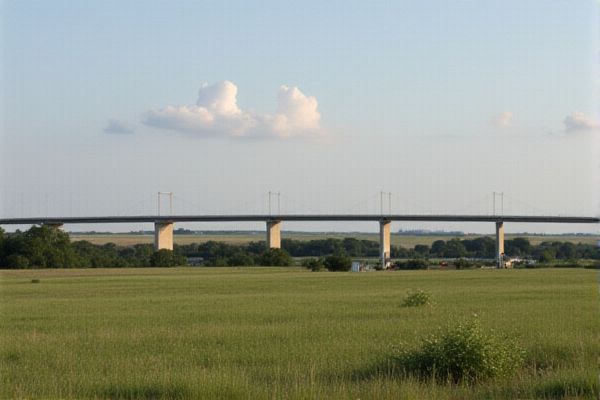
Weather and climate in Nebraska: Hot summers, cold winters. Tornado risk in spring. Snowfall during winter months. Rapid weather changes. Humid continental climate. Average rainfall varies. Thunderstorms common in summer. Chinook winds influence temperature. Low humidity levels. Mild autumns, springs.
Hot summers, cold winters.
Nebraska experiences a continental climate with distinct seasonal variations, characterized by hot summers with temperatures often soaring into the mid-90s °F (mid-30s °C) and cold winters with average high temperatures ranging from 32 °F (0 °C) to 40 °F (4 °C) and significant snowfall, especially in the northern parts of the state. For more detailed information on the state's weather patterns, visit the Weather for You website.
Tornado risk in spring.
Spring and summer bring the threat of severe thunderstorms and tornadoes to Nebraska, with these natural events often resulting in high winds, hail, and significant damage. During such occurrences, it is essential to seek shelter in basements, storm cellars, or small interior rooms without windows for safety. The year 2024 has been marked by an unusually active tornado season, highlighted by a major outbreak on April 26 that resulted in over 140 tornadoes across Nebraska, Iowa, and other Midwestern states. This event caused widespread destruction and loss, emphasizing the importance of understanding regional hazards. For more details on preparing for and responding to these natural events, visit the Emergency Management website, which provides valuable resources and guidance.
Snowfall during winter months.
In Nebraska, winter snowfall varies significantly by region. The northern panhandle receives the heaviest snowfall, with places like Chadron averaging around 50.3 inches annually, while eastern Nebraska cities like Omaha and Lincoln average around 27 inches. January snowfall averages range from 6.6 inches in Columbus to 7.2 inches in Omaha.
Rapid weather changes.
Nebraska is experiencing rapid weather changes, including increasing heat, more intense rainstorms, and heightened risks of both droughts and floods. The state can expect hotter summers, more severe storms, and a greater fraction of precipitation falling in heavy rainfall events, leading to increased flooding risks and drought severity. For more detailed insights, visit the Climate Nexus website, which provides comprehensive information on these environmental challenges facing Nebraska. As the climate continues to evolve, understanding these shifts is critical for mitigating their impact on the region's agriculture, water resources, and overall ecosystem.
Humid continental climate.
Eastern Nebraska has a Humid Continental Climate, characterized by wide variations between winter and summer temperatures, with hot summers and cold, snowy winters. This climate zone is marked by significant precipitation, especially in the southeast, averaging over 31.5 inches annually, and is distinct from the semi-arid conditions in [Western Nebraska](https://en.wikipedia.org/wiki/Nebraska). This division in climate results in diverse agricultural practices and challenges across the state.
Average rainfall varies.
Nebraska's precipitation patterns exhibit significant year-to-year variability and a pronounced east-west gradient, with annual totals decreasing by 50% from east to west. Over the 20th century, Nebraska experienced a slight increase in precipitation, with an average annual increase of 1.3 inches, primarily due to increased spring precipitation. For more detailed information on these climatic shifts, one might explore the insights provided by the Nebraska Changing Climate report, which offers an in-depth analysis of these patterns and their implications for agriculture and the environment.
Thunderstorms common in summer.
Thunderstorms in Nebraska, particularly in Southeast Wyoming and Western Nebraska, are most common during the summer months, with June and July being the peak months for hail reports, often occurring in the late afternoon and early evening, around 4 PM local time. These thunderstorms can produce severe hail, high winds, and tornadoes, contributing to significant damage and economic losses in the region. For more detailed information, visit the National Weather Service website.
Chinook winds influence temperature.
Chinook Winds, though more commonly associated with regions near the Rocky Mountains, can influence temperature in Nebraska by bringing warm, dry air from the western slopes of the mountains. These winds can cause rapid temperature increases, sometimes by as much as 50 degrees Fahrenheit (10 degrees Celsius) in a short period, significantly affecting the cold-season weather in the western Great Plains, including parts of Nebraska. For more detailed information, you can learn about this fascinating weather phenomenon on the Chinook Wind Wikipedia page.
Low humidity levels.
In Nebraska, low humidity levels are more common in the winter and in the western regions. During winter, outdoor humidity generally stays above 40%, but using heating systems can reduce indoor humidity levels further. For more detailed statistics on humidity patterns in the region, you can visit the Weather Nebraska Humidity Annual page for comprehensive insights.
Mild autumns, springs.
In Nebraska, autumn is particularly mild and appealing, with temperatures ranging from 75-80°F (24-27°C) and frequent sunny days from September to October. Spring, especially late May through early June, is also pleasant, with temperatures rising gradually and minimal humidity, although there is a risk of tornadoes during this period. For more information on the climate in this state, you can visit the Nebraska Weather Guide which offers insights into the best times to visit and experience the diverse seasons of this fascinating region.
